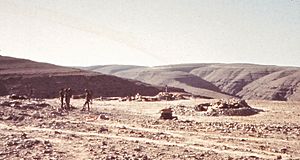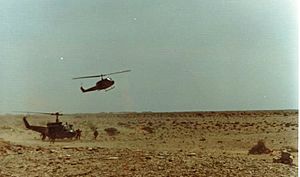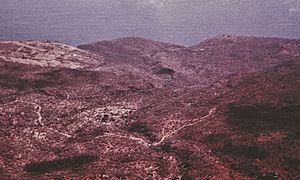Operation Simba facts for kids
Quick facts for kids Operation Simba |
|||||||
|---|---|---|---|---|---|---|---|
| Part of Dhofar Rebellion | |||||||
 SAF Sangars on the Sarfait plateau, looking towards the airstrip |
|||||||
|
|||||||
| Belligerents | |||||||
Operation Simba was a very long and important battle during the Dhofar Rebellion. This rebellion was a fight in Oman that lasted for many years. On April 17, 1972, soldiers from the Sultan of Oman's Armed Forces (SAF) used helicopters to land on a tall ridge called Sarfait. This spot was close to the border with a country called the People's Democratic Republic of Yemen (PDRY).
The main goal was to stop supplies from reaching the rebel fighters. These rebels were part of a group called the PFLOAG. Their supplies came from the PDRY along a narrow path near the coast. The soldiers at Sarfait found it hard to get water and supplies. They needed planes and helicopters to bring everything in.
This made it tough for the Sultan's Air Force, as they had to focus a lot of effort on Sarfait. Even though it was difficult, the soldiers held this position for three years. Eventually, this spot helped the Sultan's forces win the war. It became the starting point for a big attack that cut off the rebels' supply lines for good.
Contents
Why the Battle Started
The Dhofar Rebellion began in the mid-1960s. At first, a group called the Dhofar Liberation Front (DLF) wanted more control for their local area. But after Britain left Aden in 1968, and the People's Democratic Republic of Yemen was formed, the rebels got a steady supply of weapons.
This made the rebel movement stronger and more focused on big changes. They renamed themselves the Popular Front for the Liberation of the Occupied Arabian Gulf (PFLOAG). By 1970, these rebel fighters controlled most of the jebel, which is the mountainous area of Dhofar.
On July 23, 1970, the old ruler, Sultan Said bin Taimur, was replaced by his son, Qaboos bin Said al Said. Sultan Qaboos quickly started new social programs. He also began to fight back against the rebels. British Special Air Service (SAS) soldiers helped train local fighters called firqats. These groups tried to gain control of the eastern mountains.
The Sultan's Armed Forces (SAF) also became more active. One of their battalions, the Desert Regiment, was at a base called Akoot. This base was not very important for fighting. Most of the soldiers there were busy defending it and bringing in supplies like water.
The Plan for Sarfait
The Sultan's Armed Forces had recently gotten new transport planes and AB-205 helicopters. This meant they could try bigger and more daring operations. Lieutenant Colonel Nigel Knocker, who led the Desert Regiment, and his commanders looked at the area near the border with the People's Democratic Republic of Yemen.
The PFLOAG rebels got their supplies from Hawf, a town just inside the PDRY. These supplies traveled along paths known as the "Chinese Road" or "Freedom Road." These paths ran along the coast. Then, they turned north up a valley to some caves at Shershitti. From there, camels carried supplies further east.
Lieutenant Colonel Knocker planned to capture the high ground at Sarfait. This spot was very close to the PDRY border. The "Freedom Road" was hidden below the cliffs at the southern end of this ridge. So, the Desert Regiment also planned to capture a sharp, rocky peak called "Capstan" below the cliffs.
The plan relied on two things: building an airstrip on the ridge and finding water on "Capstan." Some local firqats said there was water there. Even though the plan was risky and would use most of the SAF's resources, the overall commander, Brigadier John Graham, decided it was necessary. He wanted to act before Britain completely left the Middle East, which would leave Oman on its own.
Starting the Operation
The operation, called "L Day," was set for April 17, 1972. To get ready, all the AB 205 helicopters from the Sultan's Air Force were gathered at Akoot. These helicopters were mostly flown by British pilots. The day before, 60 soldiers from the Desert Regiment and a firqa unit were flown north of Sarfait. They then moved overnight to secure the landing spot.
April 17 started with bad weather and low clouds. This almost stopped the operation. But the clouds lifted enough after a two-hour delay. Instead of one big helicopter attack, pairs of AB 205 helicopters flew back and forth all day. They carried 100 troops, weapons, sandbags, barbed wire, ammunition, and supplies from Akoot.
The helicopter flights continued for the next two days. During this time, a rough airstrip was cleared at Sarfait, which was called Simba. The first Short SC.7 Skyvan transport plane landed on April 19. That night, a strong storm hit western Dhofar. The camp at Akoot was partly flooded. The new position on the high ground at Sarfait was badly damaged. One soldier was even killed by lightning.
Challenges at Capstan
As some commanders had worried, supplying Sarfait used up too many of the Sultan's Air Force resources. Other operations had to be stopped. Some recently captured positions in the eastern mountains had to be given up. The remaining troops at Akoot were also pulled out on May 7.
The troops at Simba had not been able to take Capstan. There was only a very steep and rough gully leading down the Sarfait cliffs. On the night of May 4, two companies from the Northern Frontier Regiment tried to go down it but failed.
At first, the PFLOAG rebels did not react strongly to the capture of Simba. But on May 5, PFLOAG units inside the PDRY heavily attacked a fort at Habarut. This fort was a few miles north of Sarfait. The soldiers there lost radio contact. A small group from the Desert Regiment was flown to the area. They found the fort's radio was broken, and the soldiers had left. A British SAS soldier with the local unit had been killed.
In response, BAC Strikemaster attack planes from the Sultan's Air Force destroyed the fort on the Yemeni side of the border. On May 22, they also attacked PFLOAG bases in Hawf, inside the PDRY.
On the night of May 26, two infantry companies and a firqat unit finally managed to climb down the valley face of the Sarfait cliffs using ropes. "Capstan" was captured without a fight. As expected, it could control the "Freedom Road." However, the promised water source on "Capstan" could not be found. Also, it was impossible to supply the position by helicopter. A PFLOAG machine gun, a heavy DShK gun, controlled the landing zones on "Capstan." The SAF's Strikemaster planes could not destroy this gun. So, the soldiers on "Capstan" were pulled out after four days.
The Siege of Sarfait
Further east, the PFLOAG suffered a big loss at the Battle of Mirbat on July 19, 1972. However, the PFLOAG still thought the Sarfait position gave them a chance to win. The position could only be supplied by planes and helicopters. The airstrip was open to fire from higher ground to the north. On February 3, 1973, PFLOAG opened fire on the airstrip with 75-mm and 106-mm recoilless rifles. They destroyed one aircraft and effectively closed the airstrip.
Keeping Sarfait supplied would have been too much for the Sultan's Air Force's eight AB 205 helicopters. It seemed the soldiers would have to leave by air or retreat through rebel-controlled land. They might even have to surrender. However, Sultan Qaboos had asked other Middle Eastern countries for help when he took power. Jordan, Abu Dhabi, and Saudi Arabia, all led by kings or sheikhs, felt threatened by the PFLOAG's ideas. They were the first to offer support.
But the help from the Shah of Iran was the most important. An Iranian Battle Group, with 1600 soldiers, was sent to Dhofar. This group had six helicopters, the same kind as the Sultan's Air Force. Starting on February 15, these helicopters were enough to keep the Sarfait position supplied.
For the rest of 1973 and all of 1974, Sarfait remained under attack. It was hit by mortar bombs and rockets from time to time. Elsewhere in Dhofar, however, the PFLOAG lost support among the local tribes in the mountains. They also ran out of ammunition.
The Final Attack
By early 1975, the Sultan's Armed Forces and the Iranian Task Force were getting ready for a final attack. Their goal was to clear the rebels from the western mountains. The rebels had renamed themselves the Popular Front for the Liberation of Oman (PFLO). However, early attacks that year against the Shershitti Caves were defeated with many losses.
The final attack was called Operation Hadaf. Brigadier John Akehurst, who now commanded the Dhofar Brigade, planned to launch the main attack from a recently captured airstrip at Deefa. To distract the PFLO, a smaller attack was to be launched from Sarfait.
By this time, the Muscat Regiment, led by Lieutenant Colonel Ian Christie, held Sarfait. For weeks, the Muscat Regiment had openly cleared the gully leading down the cliffs of anti-personnel mines. But secretly, they had cleared another path that went down the back of the ridge.
On October 14, 1975, the Muscat Regiment moved at night using this secret path. They secured "Capstan" with very little fighting. Because of this unexpected success, Akehurst changed his original plan. Two more infantry companies were flown into Sarfait to help with the attack. Major General Ken Perkins, the SAF commander, ordered Hawker Hunter jets to attack the PFLO's artillery and rocket positions inside the PDRY. The SAF had recently gotten these jets from Jordan.
On October 17, these air strikes destroyed almost all the rebel guns. This greatly reduced the number of shells hitting Sarfait. The two extra companies passed through "Capstan" and reached the sea. They set up a line of small bases that effectively cut off the "Freedom Road."
The PFLO continued to attack Sarfait and the new positions. They used even heavier 130-mm guns placed further inside the PDRY. These attacks continued until December. However, the new position was strengthened and supplied with defense materials. These were brought by helicopter from a merchant ship, "Al Sultana," operated by the Sultan of Oman's Navy. The Omani attacks into the PDRY stopped on November 21. International talks led to a ceasefire in December.
On October 17, the Iranian Task Force began another distraction attack against Shershitti. The main attack by the Frontier Force Regiment, moving west from Deefa, threatened to surround the remaining rebels. Their leaders ordered them to retreat into the PDRY. They left behind many heavy weapons and ammunition. On December 2, patrols from the Muscat Regiment and Frontier Force met on the Darra Ridge, north of Sarfait. This sealed off the western mountains.
The rebellion was officially declared over on December 11, 1975. However, a few small incidents still happened until 1980. Pressure from other countries made the PDRY government order a ceasefire.
During the four years the Sultan's Armed Forces held Sarfait, it was hit by 10,000 mortar bombs, shells, and rockets. But only six soldiers were killed and twelve wounded by artillery fire. The other casualties happened during patrols and sweeps around the base.
Images for kids




